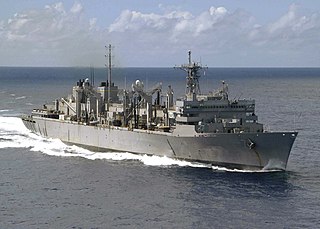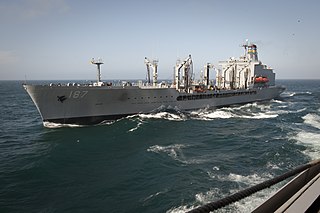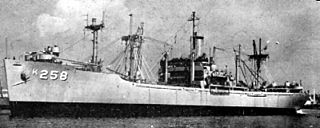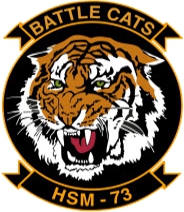
The fast combat support ship is a type of replenishment auxiliary ship. Different from traditional logistic ships, the fast combat support ship is designed with high speed to keep up with the carrier battle group/carrier strike group, while the multi-product station is capable of supplying all types of necessities for the fleet.

The Wasp class is a class of landing helicopter dock (LHD) amphibious assault ships operated by the United States Navy. Based on the Tarawa class, with modifications to operate more advanced aircraft and landing craft, the Wasp class is capable of transporting almost the full strength of a United States Marine Corps Marine Expeditionary Unit (MEU), and landing them in hostile territory via landing craft or helicopters as well as providing air support via AV-8B Harrier II attack aircraft or F-35B Lightning II stealth strike-fighters. All Wasp-class ships were built by Ingalls Shipbuilding, at Pascagoula, Mississippi, with the lead ship, USS Wasp, commissioned on 29 July 1989. Eight Wasp-class ships were built, and as of April 2021, seven are in active service, as USS Bonhomme Richard was seriously damaged by fire on 12 July 2020, and subsequently decommissioned in April 2021.

USS Thetis Bay (CVE-90) was the thirty-sixth of fifty Casablanca-class escort carriers built for the United States Navy during World War II. She was launched in March 1944, commissioned in April, and served as a transport carrier in the Pacific, as well as a replenishment carrier supporting the Allied bombardment of Tokyo and the Main Islands. Postwar, she participated in Operation Magic Carpet, before being decommissioned in August 1946, being mothballed in the Pacific Reserve Fleet. She was reactivated in July 1956, and converted to a helicopter transport carrier, serving in relief operations in Taiwan and Haiti. Ultimately, she was broken up in 1966, the last Casablanca-class hull to be scrapped.

USS Betelgeuse (AK-260) was the last of the cargo ships in service in the United States Navy. On 10 April 1944, it was renamed the SS Colombia Victory after being launched as a Victory ship to carry cargo during World War II. She was transferred to the US Navy in 1951.

Replenishment at sea (RAS) or underway replenishment (UNREP) is a method of transferring fuel, munitions, and stores from one ship to another while under way. First developed in the early 20th century, it was used extensively by the United States Navy as a logistics support technique in the Pacific theatre of World War II, permitting U.S. carrier task forces to remain at sea indefinitely.

USS Shasta (AE-33) was a Kilauea-class replenishment ammunition ship of the United States Navy. She was named after Mount Shasta, a volcano in the Cascade Range in northern California. Shasta's mission was to support forward deployed aircraft carrier battle groups, which she accomplished through underway replenishment and vertical replenishment. Over three decades, Shasta and her crew took part in the Vietnam War, the Cold War, the Iran–Iraq War, Desert Shield/Operation Desert Storm, and numerous other actions.

USS Sylvania (AFS-2), a Mars-class combat stores ship, was the second ship of the United States Navy to be named Sylvania.

USS Niagara Falls (AFS–3), a Mars-class combat stores ship, was the only ship of the United States Navy to be named after the City of Niagara Falls, New York. Commissioned into the US Navy on 29 April 1967, she served until September 1994, when she was transferred to the US Military Sealift Command to serve as USNS Niagara Falls (T-AFS-3). Assigned to the Naval Fleet Auxiliary Force, Far East, she served until 30 September 2008, when she was finally deactivated.

USS Flint (AE-32/T-AE-32) is a Kilauea-class ammunition ship of the United States Navy, and was named after the sparking rock flint. Flint was constructed at the Ingalls Nuclear Shipbuilding Division, Litton Industries, Inc., Pascagoula, Mississippi. The ship was delivered to the United States Navy at Charleston, South Carolina, on 30 August 1971.

Wichita-class replenishment oilers comprised a class of seven replenishment oilers used by the United States Navy from the late 1960s to the mid-1990s. The ships were designed for rapid underway replenishment using both connected replenishment and vertical replenishment.

Helicopter Sea Combat Squadron 25 (HSC-25) "Island Knights" is a United States Navy helicopter squadron based at Andersen Air Force Base, Guam. The "Island Knights" of HSC-25 fly the MH-60S "Knighthawk" helicopter, manufactured by Sikorsky Aircraft Corporation in Stratford, Connecticut.

Helicopter Sea Combat Squadron THREE , also known as the "Merlins", is a United States Navy multi-role combat helicopter squadron based at Naval Air Station North Island in San Diego, California which operates the Sikorsky MH-60S Knighthawk helicopter to train aircrew and support fleet development on the MH-60S for the Commander Helicopter Sea Combat Wing, U.S. Pacific Fleet. The squadron was established on 1 September 1967 at Naval Air Station Imperial Beach with the Boeing Vertol CH-46 Sea Knight to provide vertical replenishment (VERTREP) services on the West Coast, and was redesignated HSC-3 on 1 April 2005.

USNS Henry J. Kaiser (T-AO-187) is a United States Navy fleet replenishment oiler and the lead ship of her class. Her mission is to resupply U.S. Navy and allied ships at sea with fuel oil, jet fuel, lubricating oil, potable water, and dry and refrigerated goods, including food and mail.

USNS Medgar Evers (T-AKE-13) is a Lewis and Clark-class dry cargo ship of the United States Navy. As part of the Navy's Combat Logistics Force, her mission is to deliver ammunition, provisions, dry stores, refrigerated food, spare parts, potable water, and diesel and jet fuel to U.S. Navy and allied ships while at sea. The ship is named for civil rights movement activist Medgar Evers, a World War II veteran who was assassinated in 1963. The Navy announced the naming on 9 October 2009.

USS Alcor, AK-259, was a Greenville Victory-class cargo ship in service with the United States Navy from 1952 to 1968. She was originally built in 1944 as SS Rockland Victory, a World War II era Victory ship. She was sold for scrap in 1970.

Helicopter Sea Combat Squadron 9 (HSC-9) "Tridents" is a United States Navy helicopter squadron based at Naval Air Station Norfolk, Norfolk, Virginia. The squadron is equipped with the Sikorsky MH-60S Seahawk. Currently, HSC-9 is attached to Carrier Air Wing Eight. It was originally established as Helicopter Anti-Submarine Squadron 3 (HS-3) in 1952 and was redesignated on 1 June 2009.

The second USS Altair (AK-257) was a United States Navy Greenville Victory-class cargo ship in commission from 1952 to 1953. She was converted into a Antares-class general stores issue ship (AKS-32) in 1953 and was in commission as such from 1953 to 1969, seeing extensive service during the Cold War. Prior to her U.S. Navy career, she had operated as the merchant ship SS Aberdeen Victory during the latter stages of World War II.

The second USS Antares (AK-258) was a United States Navy Greenville Victory-class cargo ship in commission from 1952 to 1959. She was converted into a general stores issue ship (AKS-33) in 1959-1960 and remained in commission as such until 1964. She saw extensive service during the Cold War. Prior to her U.S. Navy career, she had operated as the merchant ship SS Nampa Victory during the latter stages of World War II and in the years immediately after the war.

Helicopter Maritime Strike Squadron 49 (HSM-49) is a United States Navy Maritime Strike helicopter squadron based Naval Air Station North Island, California.

Helicopter Maritime Strike Squadron 73 (HSM-73) is a United States Navy Maritime Strike helicopter squadron based on Naval Air Station North Island, California.






















